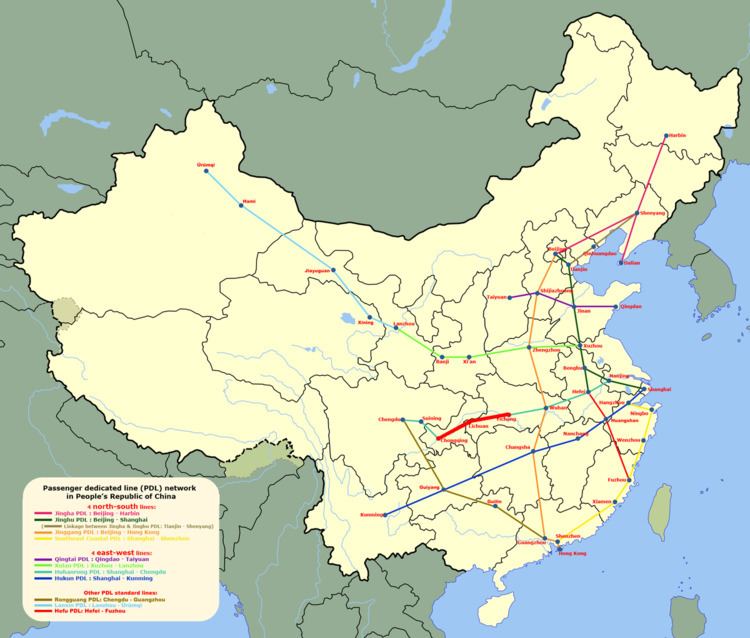Line length 377 km (234 mi) | Maximum speed 200 km/h (124 mph) | |
 | ||
The Yichang–Wanzhou Railway, or the Yiwan Railway (simplified Chinese: 宜万铁路; traditional Chinese: 宜萬鐵路; pinyin: Yíwàn Tiělù) connects the cities of Yichang (Hubei Province) and Wanzhou (Chongqing Municipality) via Lichuan, in the central People's Republic of China. It was completed in 2010, and will be part of the future Huhanrong Passenger Dedicated Line from Shanghai to Wuhan to Chengdu. Out of the line's total 377 km (234 mi) length, 288 km (179 mi) runs on bridges or in tunnels. According to the chief engineer, Zhang Mei, the line was the most difficult ever constructed in China. Operation started on 22 December 2010.
Contents
Connections
At its eastern end, the Yichang East Railway Station, the Yiwan Railway connects with the high-speed Hanyi Railway to Hankou (Wuhan).
Near Lichuan Station, the Yiwan Railway connects with the high-speed Yuli Railway (Chongqing–Lichuan (scheduled opening date, Decmebr 28, 2013). Once the Yuli line is in operation, it will become the main route of the Huhanrong corridor, and will provide the most direct connection to Chongqing, with a possibility to continue to Chengdu, as well. With the Yuli and Hanyi lines both in operation and in use by high-speed, it will become possible to travel by train between Wuhan and Chongqing in around 5 hours, compared to the 22 hours before the opening of the Yiwan Line. However, the opening of high-speed service (as opposed to "regular" trains) on the Yiwan line won't happen until July 1, 2014.
Until the Yuli line was completed at the end of 2013, all through traffic on the Yiwan Railway had to go along its entire length, to the line's western terminus at Wanzhou, and then over an existing railway branch to Dazhou, Sichuan. From Dazhou, trains could continue both southwest toward Chongqing on the Xiangyu Railway and west toward Chengdu on the Dacheng Railway (达成铁路).
Layout
The 377 km (234 mi) long railway crosses the remarkably difficult terrain of southwestern Hubei (Yichang City and Enshi Tujia and Miao Autonomous Prefecture) and the eastern part of the Chongqing Municipality (Wanzhou District). The region has numerous mountains and is sometimes referred to as "the eastern edge" of the Yunnan-Guizhou Plateau. Until recently, the region had no railways, and hardly any paved roads (beyond China National Highway 318, which the new railway more or less parallels). The new (G42 Hurong Expressway) is being built along the same corridor as well (see Si Du River Bridge for an example of engineering that was required).
Out of the entire length of the rail line, 324 km (201 mi) are in Hubei and 53 km (33 mi) in Chongqing Municipality. Owing to the difficult terrain, the project involves a large number of bridges (including two over the Yangtze River: the Wanzhou Railway Bridge and the Yichang Railway Bridge) and tunnels. Out of the line's total 377 km (234 mi) length, 288 km (179 mi) runs on bridges or in tunnels. This made the line the most difficult and the most expensive (per kilometre) of all China's railways to date. At a cost of U.S. $9.01 million per kilometre, the per-kilometre construction costs were twice as high as those for the Qinghai–Tibet Railway which cost U.S. $4.35 million per kilometre.
Construction history
The railway was first proposed by Sun Yat-sen in 1903, but construction was not started until 2003 due to the difficulties of the project. According to the chief engineer, Zhang Mei, the line was the most difficult ever constructed in China.
As of mid-2009, the embankments, bridges, and tunnels along the Yiwan Railway had been mostly completed, and about half the rails had been laid. On 18 August 2010, the line's construction was completed. Local media reported that the line would become operational in November 2010.
Trial operations started on 19 November, and regular operation started on 22 December 2010, with passenger trains from Wuhan running to Lichuan; on 10 January 2011 a through-passenger service from Wuhan to Chongqing over the entire Yiwan line will start.
